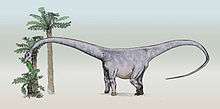1890 in paleontology
Paleontology or palaeontology is the study of prehistoric life forms on Earth through the examination of plant and animal fossils.[1] This includes the study of body fossils, tracks (ichnites), burrows, cast-off parts, fossilised feces (coprolites), palynomorphs and chemical residues. Because humans have encountered fossils for millennia, paleontology has a long history both before and after becoming formalized as a science. This article records significant discoveries and events related to paleontology that occurred or were published in the year 1890.
| |||
|---|---|---|---|
Plants
Pteridophyta
| Name | Novelty | Status | Authors | Age | Type locality | Location | Notes | Images |
|---|---|---|---|---|---|---|---|---|
|
Azollophyllum primaevum[2] |
Sp nov |
jr synonym |
moved to Azolla primaeva in 1955 |
| ||||
Archosauromorphs
Newly named pseudosuchians
| ||||||||||||||
Newly named non-avian dinosaurs
|
||||||||||||||||||||||||||||||||||||||
Sauropterygia
New taxa
|
| |||||||||||||||||||
References
- Gini-Newman, Garfield; Graham, Elizabeth (2001). Echoes from the past: world history to the 16th century. Toronto: McGraw-Hill Ryerson Ltd. ISBN 9780070887398. OCLC 46769716.
- Arnold, C.A. (1955). "A Tertiary Azolla from British Columbia" (PDF). Contributions from the Museum of. Paleontology, University of Michigan. 12 (4): 37–45.
- Lydekker, R. 1890, Catalogue of the Fossil Reptilia and Amphibia in the British Museum (Natural History), Part IV. Containing the orders Anomodontia, Ecaudata, Caudata, and Labyrinthodonta, and Supplement, p. 1-295.

